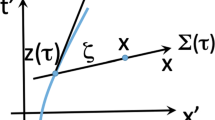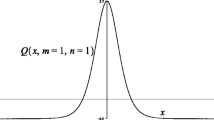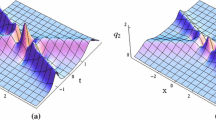Abstract
In 1927 Louis de Broglie proposed an alternative approach to standard quantum mechanics known as the double solution program (DSP) where particles are represented as bunched fields or solitons guided by a base (weaker) wave. DSP evolved as the famous de Broglie-Bohm pilot wave interpretation (PWI) also known as Bohmian mechanics but the general idea to use solitons guided by a base wave to reproduce the dynamics of the PWI was abandoned. Here we propose a nonlinear scalar field theory able to reproduce the PWI for the Schrödinger and Klein–Gordon guiding waves. Our model relies on a relativistic ‘phase harmony’ condition locking the phases of the solitonic particle and the guiding wave. We also discuss an extension of the theory for the N particles cases in presence of entanglement and external (classical) electromagnectic fields.



Similar content being viewed by others
Data Availability
Data Availability Statement: No Data associated in the manuscript.
Notes
In the rest of this article contravariant and covariant vectors \(F^\mu\), \(F_\mu\) are often written in the compact form F to simplify the notations. With this convention the scalar product reads \(A_\mu B^\mu :=AB\).
We stress that in order to identify \(\frac{d}{d\tau }\ln {[\mathcal {M}_\Psi (\tau )]}\) and \(\frac{d}{d\tau }\ln {[\mathcal {M}_u(\tau )]}\) we must use \(\mathcal {M}_u(x)\simeq \mathcal {M}_u(z)+ O(\xi )\). The time derivative \(\partial_t\mathcal {M}_u(x)\) computed in the rest frame \(\mathcal {R}_\tau\) includes the derivative of \(O(\xi )\). Using methods developed in Appendix 1 we can indeed justify the condition \(\frac{d}{d\tau }\ln {[\mathcal {M}_\Psi (\tau )]}=\frac{d}{d\tau }\ln {[\mathcal {M}_u(\tau )]}\).
We stress that in order to neglect the self electric energy associated with the electric charge distribution we must have \(\frac{e^2}{a}\ll \frac{b}{\omega_0}=\frac{1}{\omega_0a^2}\), i.e. \(a\ll \frac{(\omega_0)^{-1}}{e^2}\). Moreover, the Sommerfeld structure fine constant \(\alpha =\frac{e^2}{4\pi }\simeq 1/137\) is very small and the previous condition is easy to fulfill for droplet of extension a smaller or equal to the Compton wavelength of the particle \((\omega_0)^{-1}.\)
We note that at the beginning of the present research the author was motivated by an extension of Gueret and Vigier nonlinear equation [42]: \(D^2u=\frac{\Box |u|}{|u|}u-\mathcal {M}_\Psi ^2u\) (in [42] the mass \(\mathcal {M}_\Psi\) was replaced by \(\omega_0\)) that leads directly to the relation \((\partial \varphi +eA)^2=\mathcal {M}_\Psi ^2=(\partial S+ eA)^2\). This implies \(\forall x\) \(\partial S =\partial \phi\), i.e., \(S(x)\equiv \varphi (x)\) (the contact between S and \(\varphi\) is thus stronger than in the phase harmony considered in this work). However, it lets f(x) relatively unconstrained. In fact, from the conservation laws \(\partial [a^2(\partial S+eA)]=0\), \(\partial [f^2(\partial S+eA)]=0\) (with \(S=\varphi\)) we deduce \(v_\psi \partial \log {[f/a]}=0\) meaning that the ratio f/a is constant along a current line. This is a problem since a(x) can increase or decrease and this goes against the notion of a permanent particle (for more on this issue see [19]).
This equation can be derived from the definition \(\mathcal {M}^2_u:=(\partial \varphi +eA)^2\) and by applying the gradient operator \(\partial\) on both sides of the relation.
Note that we have also \(\delta \tau =\int_0^{t_1} dt_1\sqrt{(1-({\textbf {a}}(0)t_1)^2)}\simeq t_1\)
References
Miller, A.I.: Albert Einstein’s Special Theory of Relativity: Emergence (1905) and Early Interpretations (1905–1911). Springer, New York (1997)
Mie, G.: Grundlagen einer Theorie der Materie. Ann. der Phys. (Berlin) 99, 1–40 (1912)
Born, M., Infeld, L.: Foundations of the new field theory. Proc. R. Soc. A Math. Phys. Eng. Sci. 144, 425–451 (1934)
Einstein, A., Rosen, N.: The particle problem in the general theory of relativity. Phys. Rev. 48, 73–77 (1935)
Fargue, D.: Permanence of the corpuscular appearance and non linearity of the wave equation. In: Diner, S., et al. (eds.) The Wave-Particle Dualism, pp. 149–172. D. Reidel, Dordrecht (1984)
De Broglie, L.: La mécanique ondulatoire et la structure atomique de la matière et du rayonnement. J. Phys. Radium 8, 225–241 (1927); translated in: de Broglie, L., Brillouin, L.: Selected Papers on Wave Mechanics. Blackie and Son, Glasgow (1928)
De Broglie, L.: Une tentative d’interprétation causale et non linéaire de la mécanique ondulatoire: la théorie de la double solution. Gauthier-Villars, Paris (1956); translated in: de Broglie, L.: Nonlinear Wave Mechanics: A Causal Interpretation. Elsevier, Amsterdam (1960)
Bialynicki-Birula, I., Mycielski, J.: Nonlinear wave mechanics. Ann. Phys. 100, 62–93 (1976)
Kiessling, M.K.H.: Quantum Abraham models with de Broglie Bohm laws of electron motion. AIP Conf. Proc. 844, 206 (2006)
Benci, V.: Solitons and Bohmian mechanics, discrete and continuous dynamical systems. Discret. Contin. Dyn. Syst. 8, 303–317 (2002)
Durt, T.: Generalized guidance equation for peaked quantum solitons and effective gravity. EPL 114, 10004 (2016)
Borghesi, C.: Equivalent quantum equations in a system inspired by bouncing droplets experiments. Found. Phys. 47, 933–958 (2017)
Babin, A., Figotin, A.: Neoclassical Theory of Electromagnetic Interactions. Springer, London (2016)
Babin, A., Figotin, A.: Wave-corpuscle mechanics for electric charges. J. Stat. Phys. 138, 912–954 (2010)
Holland, P.H.: Uniting the wave and the particle in quantum mechanics. Quant. Stud. Math. Found. 7, 155–178 (2020)
Durt, T.: Testing de Broglie’s double dolution in the mesoscopic regime. Found. Phys. 53, 2 (2023)
Fargue, D.: Louis de Broglie’s “double solution’’, a promising but unfinished theory. Ann. Fond. Broglie 42, 9–18 (2017)
Collin, S., Durt, T., Willox, R., de Broglie’s, L.: double solution program: 90 years later. Ann. Fond. Broglie 42, 19–70 (2017)
Drezet, A.: The guidance theorem of de Broglie. Ann. Fond. Broglie 46, 65–85 (2021)
Borghesi, C.: Dualité onde-corpuscule formée par une masselotte oscillante dans un milieu élastique : étude théorique et similitudes quantiques. Ann. Fond. Broglie 42, 161–196 (2017)
Drezet, A., Jamet, P., Bertschy, D., Ralko, A., Poulain, C.: Mechanical analog of quantum bradyons and tachyons. Phys. Rev. E 102, 052206 (2020)
Bush, J.W.: The new wave of pilot-wave theory. Phys. Today 68, 47–53 (2015)
Bush, J.W.M.: Pilot-wave hydrodynamics. Annu. Rev. Fluid Mech. 47, 269 (2015)
Bush, J.W.M., Oza, A.U.: Hydrodynamic quantum analogs. Rep. Prog. Phys. 84, 017001 (2020)
Couder, Y., Fort, E.: Single-particle diffraction and interference at a macroscopic scale. Phys. Rev. Lett. 97, 154101 (2006)
Eddi, A., Fort, E., Moisy, F., Couder, Y.: Unpredictable tunneling of a classical wave-particle association. Phys. Rev. Lett. 102, 240401 (2009)
Fort, E., Eddi, A., Boudaoud, A., Moukhtar, J., Couder, Y.: Path-memory induced quantization of classical orbits. Proc. Natl Acad. Sci. U.S.A. 107, 17515 (2010)
Harris, D.M., Moukhtar, J., Fort, E., Couder, Y., Bush, J.W.M.: Wavelike statistics from pilot-wave dynamics in a circular corral. Phys. Rev. E 88, 011001(R) (2013)
Bacciagaluppi, G., Valentini, A.: Quantum Theory at the Crossroads: Reconsidering the 1927 Solvay Conference. Cambridge University Press, Cambridge (2009)
Bohm, D.: A suggested interpretation of the quantum theory in terms of “hidden’’ variables. Phys. Rev. 85, 166–179 (1952)
Bohm, D., Hiley, B.J.: The Undivided Universe. Routledge, London (1993)
Petiau, G.: Sur la représentation des corpuscules en interaction avec des champs extérieurs par des fonctions d’ondes à singularités localisées. C. R. Acad. Sci. (Paris) 239, 344–346 (1954)
Petiau, G.: Sur la détermination de fonctions d’ondes à singularités localisées mobiles décrivant des trajectoires circulaires dans le cas d’un potentiel extérieur central. C. R. Acad. Sci. (Paris) 239, 2491–2493 (1955)
Petiau, G.: Quelques cas de représentation des corpuscules en intéraction avec des champs extérieurs dans la nouvelle forme de la mécanique ondulatoire (Théorie de la double solution). Séminaire L. de Broglie: Théories Physiques (Paris) 24, exposé 18 (1954–1955)
Roberts, J.: Particule en mouvement dans l’espace et soumise à un champ de force uniforme. Ann. Fond. Broglie 46, 147–167 (2021)
Peyrard, M., Dauxois, T.: Physics of Solitons. Cambridge University Press, Cambridge (2006)
Born, M.: Die Theorie des starren Elektrons in der Kinematik des Relativitätsprinzips. Ann. Phys. 30, 1 (1909)
Jentzen, R.T., Ruffini, R.: Fermi and electromagnetic mass. Gen. Relativ. Gravit. 44, 2063–2076 (2012)
Poincaré, H.: Sur la dynamique de l’électron. Rend. Circ., Mat. Palermo 21, 129 (1906)
Rosen, G.: Dilatation covariance and exact solutions in local relativistic field theories. Phys. Rev. 183, 1186–1188 (1969)
Reinisch, G., Fernandez, J.C.: Ehrenfest theorem for nonlinear Klein–Gordon solitary waves. Phys. Rev. Lett. 67, 1968–1970 (1991)
Guerret, P., Vigier, J.P.: De Broglie’s wave particle duality in the stochastic interpretation of quantum mechanics: a testable physical assumption. Found. Phys. 12, 1057–1083 (1982)
Dirac, P.A.M., Fock, V.A., Podolsky, B.: On quantum electrodynamics. Phys. Z. Sowjetunion 2, 468 (1932)
Bell, J.S.: Speakable and Unspeakable in Quantum Mechanics. Cambridge University Press, Cambridge (2004)
Dürr, D., Goldstein, S., Muench-Berndl, K., Zanghì, N.: Hypersurface Bohm–Dirac models. Phys. Rev. A 60, 2729–2736 (1999)
Fabbri, L.: Spinors in polar form. Eur. Phys. J. Plus 136, 354 (2021)
Fabbri, L.: Weyl and Majorana Spinors as Pure Goldstone Bosons. Adv. Appl. Clifford Algebras 32, 3 (2022)
Ruggiero, M.L., Tartaglia, A.: Am. J. Phys. 71, 1303–1313 (2003)
Author information
Authors and Affiliations
Corresponding author
Ethics declarations
Competing interests
The author declares no competing interest for this work.
Additional information
Publisher's Note
Springer Nature remains neutral with regard to jurisdictional claims in published maps and institutional affiliations.
Rights and permissions
Springer Nature or its licensor (e.g. a society or other partner) holds exclusive rights to this article under a publishing agreement with the author(s) or other rightsholder(s); author self-archiving of the accepted manuscript version of this article is solely governed by the terms of such publishing agreement and applicable law.
About this article
Cite this article
Drezet, A. Quantum Solitodynamics: Non-linear Wave Mechanics and Pilot-Wave Theory. Found Phys 53, 31 (2023). https://doi.org/10.1007/s10701-023-00671-4
Received:
Accepted:
Published:
DOI: https://doi.org/10.1007/s10701-023-00671-4




